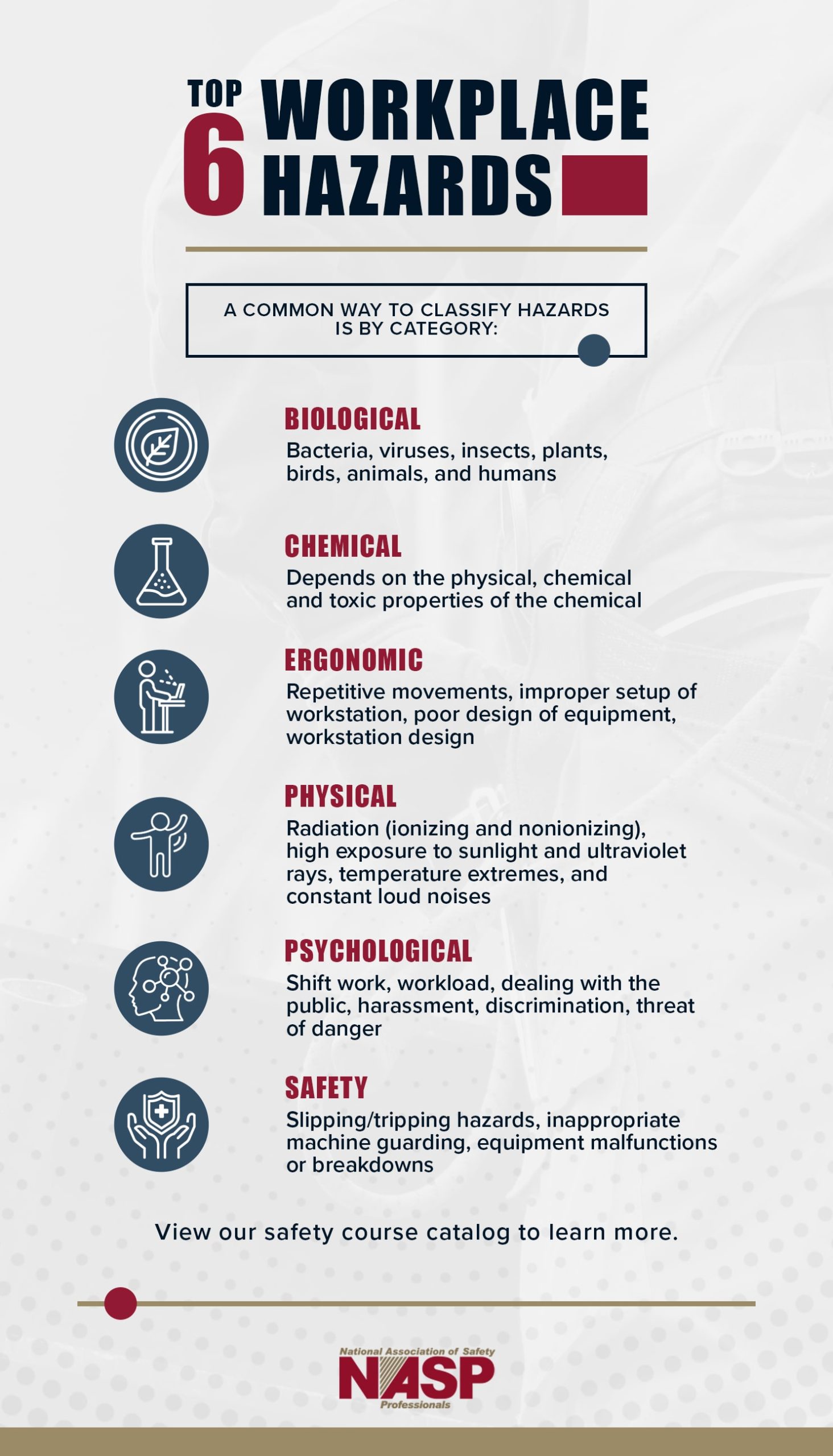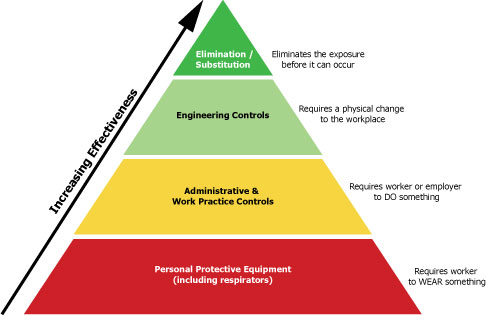Describe Three Common Methods of Chemical Exposure
What is the difference between acute and chronic chemical toxicity. Inhalation breathing Skin or eye contact Swallowing ingestion or eating Injection.

Types Of Hazards National Association Of Safety Professionals
Acute chemical exposure involves.

. Being aware of chemicals in everyday products. Chemicals dusts fumes and other toxic substances in the working environment can enter the bodies of workers in a few key ways. What are primary methods of chemical exposure.
Inhalation is breathing or inhaling into the lungs. Inhalation skin contact ingestion. Treat patients eg antineoplastic drugs aerosolized medications anesthetic gases Clean disinfect and sterilize work surfaces eg phenolics quaternary ammonium compounds bleach and medical supplies and instruments eg ethylene oxide glutaraldehyde As a fixative for tissue specimens.
Through the Mouth Ingestion Through the Eyes Ophthalmic Absorption Through the Skin Dermal Absorption Preventing Chemical Exposure. These risks are only too real. For example exposure to.
Dermal absorption The most common path of exposure to toxic substances is by contact with the skin. There are three basic exposure pathways. Ingestion is taking something in by mouth.
Inhalation of toxic vapors mists gases or dusts can produce poisoning by absorption through the mucous membrane of the mouth throat and lungs and can seriously damage these tissues by local. Everything is a chemical. The different ways a person can come into contact with hazardous chemicals are called exposure pathways.
These chemicals are used to do the following. But the market is flooded with new chemicals every day and there is little information available about which. Describe how chemicals.
What are three primary methods of chemical exposure. Heart kidney liver and lung tissue could be damaged as a result of exposure to chemicals. Rotate inventory to ensure older products are used first.
Pathways of Exposure 1 --- Dermal Absorption Exposure to toxic substances usually occurs by one of three major pathways. Most of OSHAs PELs for Shipyard Employment are contained in 19151000 Toxic and Hazardous Substances and are listed by chemical name. The skin is composed of three main parts.
Describe the difference between chronic and acute chemical exposure. Improved Methods for Estimating Chemical Exposure. Reading labels that warn you about chemical exposure.
MSHA PEL 10 mgm 3 MRE quartz. Dermal absorption inhalation and ingestion. Identify four methods of personal protection against chemical exposure.
There are four major routes by which a chemical may enter the body. Historically a work shift has been eight hours per day and this is often expressed as the allowable 8-hour TWA. Common types of occupational standards for acceptable exposure to chemicals in air include.
TWA - Time Weighted Average Represents the allowable average chemical concentration in air for a given period of time. When the quartz content of the respirable dust exceeds 5 in a coal mine sample the MSHA PEL is reduced based on the following formula. Preventing chemical exposure at the source is the most effective way of ensuring that your workers are not exposed to the dangerous chemicals they are required to handle to do their jobs.
The first is our increasing exposure to pesticides herbicides antibiotics pharmaceuticals and other chemicals and toxins in our food and water supply. The OSHA PEL of 2 fibers per cubic centimeter fcc for asbestos was reduced to 02 fcc on July 21 1986 and to 01 fcc on October 11 1994. The air we breathe is composed of chemicals including nitrogen oxygen and small amounts of argon and carbon dioxide.
Exposure to chemicals may occur by the following routes. These chemicals ensure that the products serve their purposes. Check expiration date 5.
Not burning treated wood. Change in color is a common sigh that chemical has deteriorated. At breakfast we might drink orange juice or.
Avoid exposure to light. Washing fruits and vegetables. Most of OSHAs PELs for Construction are contained in 192655 Gases Vapors Fumes Dusts and Mists and are listed by chemical name.
Being aware of any contamination pollution or hot spots areas known to have harmful amounts of contamination around your home or work. Describe three common methods of chemical exposure. What are the three primary methods of chemical exposure.
Explain the purpose of a material safety data sheet. Acute - high levels of exposure over a short period. Inhalation ingestion and skin contact.
Short-term exposure in large quantity. In the morning we brush our teeth with toothpaste that contains chemicals like fluoride to help strengthen and protect teeth and sodium bicarbonate to help remove plaque from teeth. Describe the components of a Hazard Communication Program.
Contact with skin and eyes or. However many of these limits are outdated. Light is the primary cause of the deterioration of sodium hypochlorite epinephrine hydrogen peroxide.
The three most effective ways to control and prevent chemical exposure at the source are substitution mechanization or engineering controls and administrative and work practices. Washing your hands. The symptoms of chemical exposure depend on the type of chemical that a person is exposed to and the type of exposure.
The second is our increased consumption of processed foods fast food and food no longer in a natural state. Chronic - many repeated exposures generally to lower levels over a much longer time. Chemicals are present in every product we usefrom hand sanitizer to kitchen cutting boards to the drywall in our homes.
What are the most common causes of vaccine compromise. Inhalation skin contact and ingestion. Ingestion of poisons exposure to toxic fumes and long-term exposure to chemicals.
Consider three forms of chemical health hazards found in most workplaces.

Chemical Hazards And Toxic Substances Controlling Exposure Occupational Safety And Health Administration



No comments for "Describe Three Common Methods of Chemical Exposure"
Post a Comment